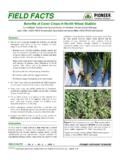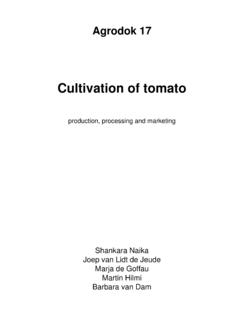Transcription of Table Grapes Postharvest Quality Maintenance …
1 Table Grapes Postharvest Quality Maintenance guidelines Carlos H. Crisosto Pomology Department University of California Davis, CA 95616 Joseph L. Smilanick Horticultural Crops Research Laboratory USDA-ARS 2021 South Peach Avenue Fresno CA 93727 Scientific Name and Introduction The Table grape (Vitis vinifera L.) is a non-climacteric fruit with a relatively low rate of physiological activity, is subject to serious water loss following harvest, which can result in stem drying and browning, berry shatter, and even wilting and shriveling of berries. Gray mold, caused by the fungus Botrytis cinerea, requires constant attention and treatment during storage and handling. In California the major cultivars are Thompson Seedless (Sultanina) and Flame Seedless marketed mostly during the summer months up to 8-10 weeks after harvest.
2 Present interest centers on other introduced seedless 'Fantasy' cultivars such as 'Ruby Seedless', and 'Crimson'. The seeded 'Red Globe', cultivar is becoming important late in the season. Quality Characteristics and Criteria High consumer acceptance is attained for fruit with high SSC or SSC/TA ratio. Berry firmness is also an important factor for consumer acceptance as are lack of defects such as decay, cracked berries, stem browning, shriveling, sunburned, dried berries, and insect damage. Horticultural Maturity Indices In California, harvest date is determined by Soluble Solids Concentration (SSC) of 14 to depending on cultivar and production area. In early production areas, an SSC/TA ratio of 20 or higher is used to determine minimum maturity for cultivars that meet a low minimum SSC.
3 For red and black colored cultivars, there is also a minimum color requirement. Grades, Sizes and Packaging Most California Table Grapes are being packed in the field. In contrast to South Africa and Chile, few Grapes are shed packed. The most common field-packing system is the "avenue pack." The fruit is picked and placed into picking lugs. Usually, the picker also trims the cluster. The picking lug is then transferred a short distance to the packer, who works at a small and shape portable stand in the avenue between vineyard blocks. Shed-packed fruit is harvested by pickers and placed in field lugs without trimming. Then placed in the shade of the vines to await transport to the shed. At the packing shed the field lugs are distributed to packers who select, trim, and pack the fruit.
4 Often two different grades are packed simultaneously by each packer to facilitate Quality selection. In some operations, trimming, color sorting, and a first Quality sorting may occur in the field. In all of the systems, Grapes are nearly always packed on a scale to facilitate packing to a precise net weight, whether field or shed packed. In general mid and late season Grapes are packed in plastic bags or wrapped in paper. For early season Grapes , bulk pack is mainly used. In all cases, packed lugs are subject to Quality inspection and check weighing. After packing and lidding, Grapes are palletized, on disposable or recycled pallets. Some strapping in the field before loading is necessary in Grapes packed in shoebox boxes. Often loaded pallets coming from the field pass through a "pallet squeeze," a device that straightens and tightens the stacks of containers.
5 These pallet loads are unitized, usually by strapping or netting. Some palletizing glue is used in shedpacking operations. This glue bonds the corrugated containers vertically on the pallet so that only horizontal strapping is required. Pre-cooling conditions Cooling must start as soon as possible and SO2 applied within 12 hours of harvest. Many grape forced-air coolers in California are designed to achieve 7/8 cooling in 6 hours or less. After cooling is completed, the pallets are moved to a storage room to await transport. Optimum Storage Conditions Ideally the storage room operates at -1o to 0oC (30oC to 32oF) and 90 to 95 percent RH, with a moderate airflow 20-40 CFM per ton stored Grapes . The constant low temperature, high RH and moderate airflow are important to limit the rate of water loss from fruit stems.
6 Fruit should be stored at (31-32oC) pulp temperature throughout its Postharvest life. Optimum Temperature Storage temperature of to (30-32oF) is recommended for mature fruit. Freezing damage may occur in less mature Grapes . The highest freezing point for berries is (26oF), but freezing point varies depending on SSC. A (28oF) freezing point for stems has been reported for wine Grapes . New Table grape cultivars are more sensitive to stem freezing damage. 90-95% RH and an air velocity of approximately 20-40 feet per minute (FPM) is suggested during storage. Controlled Atmosphere (CA) Considerations CA (2-5% O2 + 1-5% CO2) during storage/ shipment is not currently recommended for Table Grapes because its benefit is slight and SO2 is used for decay control. CO2 at 10-15% in air can be used to control grey mold for up to 2-4 weeks (depending of cultivar).
7 CO2 at 5-10% can be combined with CA to provide decay control equally effective to SO2. Retail Outlet Display Considerations Use of cold Table during display is recommended. Chilling Sensitivity They are not chilling sensitive. Rates of Ethylene Production and Sensitivity < ?m l/kg ? hr at 20oC (68oF). Table Grapes are not very sensitive to ethylene. Respiration Rates (of grape clusters, berries + stems) Temperature ml CO2/kg hr* 0oC (32oF) 1-2 5oC (41oF) 3-4 10oC (50oF) 5-8 20oC (68oF) 12-15 Stem respiration rate is approximately 15 times higher than berry respiration. * To calculate heat production, multiply ml CO2/kg hr by 440 to get BTU/ton/day or by 122 to get kcal/metric ton/day. Physiological Disorders Shatter: (loss of berries from the cap stem).
8 In general, shatter increases in severity with increasing maturity, , the longer the fruit remains on the vine. Berries of seedless cultivars are usually less well attached to the cap stem than seeded cultivars. Shatter varies considerably from season to season, and there is a large difference among varieties. Gibberellin applied at fruit set weakens berry attachment. Shatter occurs mainly due to rough handling during field packing with additional shatter occurring all the way to the final retail sale. Shatter incidence can be reduced by controlling pack depth and fruit packing density (cubic inches per pound), using cluster bagging, gentle handling, and maintaining recommended temperature and relative humidity. Cane girdling reduces shattering incidence. Waterberry: Waterberry is associated with fruit ripening and most often begins to develop shortly after veraison (berry softening).
9 The earliest symptom is the development of small (1-2 mm) dark spots on the cap stems (pedicles) and/or other parts of the cluster framework. These spots become necrotic, slightly sunken, and expand to affect more areas. The affected berries become watery, soft, and flabby when ripe. In California, this disorder has been associated with a high nitrogen status vine, canopy shading, or cool weather during veraison and fruit ripening. Avoid over fertilization with nitrogen. Foliar nutrient sprays of nitrogen should be avoided in waterberry-prone vineyards. Trimming off affected berries during harvest and packing is a common practice, although labor intensive. Postharvest Pathology Gray Mold: (Botrytis cinerea). Gray mold is the most destructive of the Postharvest diseases of Table Grapes , primarily because it develops at temperatures as low as 31oF ( ) and grows from berry to berry.
10 Gray mold first turns berries brown, then loosens the skin of the berry, its white, thread-like hyphal filaments erupt through the berry surface, and finally masses of gray colored spores develop. Wounds on berry surface near harvest provide opportunities for infection. Although no wound is required for infection when wet conditions occur. Removing desiccated infected Grapes from previous season can reduce GRAY MOLD infection. Leaf-removal canopy management, pre-harvest fungicides, trimming visibly infected, split, cracked, or otherwise damaged Grapes before packing is recommended. Prompt cooling and fumigation with sulfur dioxide (100ppm for one hour is essential to control gray mold during cold storage). Because of increased interest in the export market, there is a need to use SO2 generating pads, especially for long-distance export marketing where Grapes are in ocean transport for extended periods.



